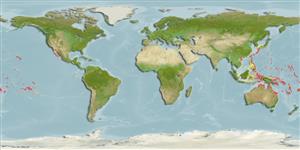>
Blenniiformes (Blennies) >
Blenniidae (Combtooth blennies) > Salariinae
Etymology: Blenniella: Diminutive of blennius, Greek,blenios = mucus (Ref. 45335).
More on authors: Bryan & Herre.
Environment: milieu / climate zone / depth range / distribution range
Ecologie
marien rifbewoner; diepte 0 - 3 m (Ref. 86942). Tropical
Western Pacific: southern Sulawesi; Palau to Marquesan and Ducie islands, north to Marcus Islands, south to Great Barrier Reef; throughout Micronesia; replaced by Blenniella periophthalmus in the Indian Ocean and southeast Asia from Ryukyus through Solomons to Santa Cruz Islands (Ref. 37816).
Grootte / Gewicht / Leeftijd
Maturity: Lm ? range ? - ? cm
Max length : 12.5 cm SL mannelijk / geslacht onbekend; (Ref. 9962); 13.1 cm SL (female)
Korte beschrijving
Determinatiesleutels | Morfologie | Morfometrie
Dorsale stekels (totaal) : 12 - 14; Dorsale zachte stralen (totaal) : 18 - 21; Anale stekels: 2; Anale zachte stralen: 20 - 21; Wervels: 37 - 39. Diagnosis: Dorsal fin XII-XIV, 18-21, notched between spinous and segmented-ray portions; anal fin II, 20-21; pectoral rays 13-15 (usually 14); pelvic fin I, 3; caudal fin, procurrent rays 7, segmented rays 13. Vertebrae 12 + 25-27. Orbital cirrus simple and slender, may have a short lateral branch, less often up to 4 branches; nasal cirri short and palmate, may rarely have more than 6 branches; nuchal cirri simple and slender, may have a single branch or a ragged edge. Mandibular pores 6. Dorsal lips margin entire, ventral margin crenulated. Occipital crest absent, but large males have a low thin ridge (less than 1.8 mm); no crest or ridge in females (Ref. 9962).
Adults are common on exposed outer intertidal reef flats, in areas with numerous cracks and holes. They feed on filamentous algae and associated minute invertebrates, e.g., foraminiferans, ostracods, copepods, and gastropods (Ref. 37816). Oviparous. Eggs are demersal and adhesive (Ref. 205), and are attached to the substrate via a filamentous, adhesive pad or pedestal (Ref. 94114). Larvae are planktonic, often found in shallow, coastal waters (Ref. 94114).
Levenscyclus en paargedrag
Maturiteit | Voortplanting | Paaien | Eieren | Fecunditeit | Larven
Oviparous, distinct pairing (Ref. 205).
Springer, V.G. and J.T. Williams, 1994. The Indo-West Pacific blenniid fish genus Istiblennius reappraised: a revision of Istiblennius, Blenniella, and Paralticus, new genus. Smithson. Contrib. Zool. 565:1-193. (Ref. 9962)
Status op de Rode Lijst van het IUCN (Ref. 130435: Version 2024-2)
Gevaar voor de mens
Harmless
Gebruik door de mens
Tools
Speciale rapporten
Download XML
Internetbronnen
Estimates based on models
Preferred temperature (Ref.
123201): 24.7 - 29.4, mean 28.1 °C (based on 1052 cells).
Fylogenetische diversiteitsindex (Ref.
82804): PD
50 = 0.5020 [Uniqueness, from 0.5 = low to 2.0 = high].
Bayesian length-weight: a=0.00776 (0.00356 - 0.01695), b=3.00 (2.81 - 3.19), in cm total length, based on LWR estimates for this (Sub)family-body shape (Ref.
93245).
Trofisch niveau (Ref.
69278): 3.1 ±0.40 se; based on food items.
Weerstandsvermogen (Ref.
120179): Hoog, minimale populatieverdubbelingstijd minder dan 15 maanden (Preliminary K or Fecundity.).
Fishing Vulnerability (Ref.
59153): Low vulnerability (10 of 100).
Nutrients (Ref.
124155): Calcium = 132 [64, 212] mg/100g; Iron = 0.708 [0.398, 1.203] mg/100g; Protein = 18.4 [17.2, 19.5] %; Omega3 = 0.0771 [, ] g/100g; Selenium = 15.7 [7.3, 34.6] μg/100g; VitaminA = 149 [45, 491] μg/100g; Zinc = 2.01 [1.31, 2.90] mg/100g (wet weight);
